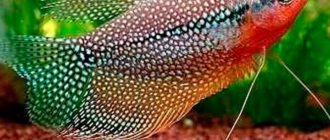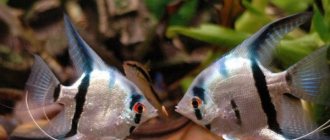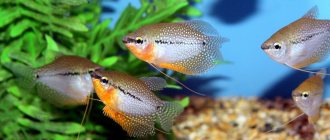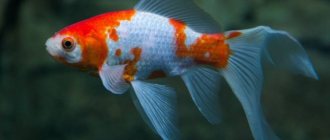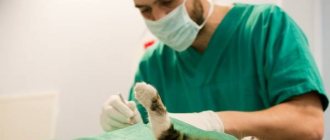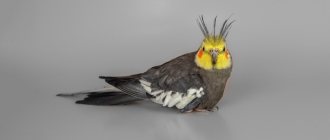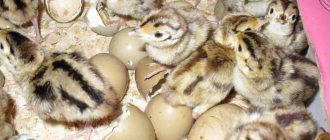Anatomy of the structure of the reproductive organs in dogs
Bitches vagina
The reproductive system of bitches consists of the ovaries, fallopian tubes, uterus, vagina, and loop.
The ovaries are attached to the body of the uterus by the uterine horns and are located in the abdominal cavity. The development and maturation of puppies occurs in the horns of the uterus. The body of the uterus, the entrance to the uterus and the vagina form a tube, which is lined inside with a mucous membrane.
The system ends with the external genital loop. Petya consists of the labia, and they are connected at the bottom by adhesions near the urinary opening and the clitoris. The clitoris consists of a cavernous body and many nerve endings. During an erection, blood flows to the clitoris and increases the sensitivity of the vulva.
The structure of the reproductive system in dogs
The structure of the penis in a male dog
The system consists of: the prostate gland, spermatic cords, testes, bulb, penis and prepuce.
Sperm is formed and matures in the testes; vital activity is supported by secretions from the prostate gland.
The testis is attached to the spermatic cord and sags in the scrotum. The male penis contains a bone inside that runs along the urethra.
When the dog is excited, blood flows to the penis, an erection occurs. The penis increases in volume and extends outward from the prepuce (foreskin). The prepuce protects the head from external influences by stretching the cranial muscle. The vas deferens is a narrow tube that originates from the tail of the epididymis. The duct passes into the ejaculatory canal, which is located at the base of the genitourinary canal.
Reproductive organs in dogs
The reproductive organs of both males and females may be underdeveloped due to pathologies, genetic diseases, and injuries at an early age.
The veterinarian will check your pet for infections or development of pathologies.
Dog vagina depth
Male
The main distinguishing features of the male genitals are:
- the presence of a bone in the penis, which can break during mating or a rough attempt to breed animals at the time of mating. The prognosis for recovery is very restrained, since in order for the bone to heal, rest is needed, but even with a seemingly favorable outcome, negative consequences are possible: the presence of pain during knitting or the formation of a callus that compresses the urethra;
- the dual function of the penile bulb, which, increasing in size during mating, forms a so-called lock together with the bitch’s genitals, and in addition, stimulates contractions of the vagina, due to which sperm reach the cervix and horns of the uterus. It should be noted that the protruding part of the male genital organs, mistakenly called the penis, represents only its head with erectile bulbs;
- significant length of the ischiocavernosus muscle reaching the perineum;
- the union of the urinary and reproductive tracts, which, in particular, explains why diseases of the prostate and bladder equally negatively affect the quality of semen (changes in pH, formation of stones.).
The time at which a dog reaches puberty depends primarily on the size of the adult animal (from 6 months for dwarf breeds to 18 months for the largest).
Labrador usually reaches sexual maturity by 12 months, it is by this time that the first sperm endowed with fertilizing ability are produced in its testes. However, the first ejaculates are still quite weak, so one should not judge the capabilities of a male dog as a producer based on them. The fertile period begins at 14 months and ends depending on the individual
of the animal (most often by the age of 10), since although the quality of sperm deteriorates mainly with age, other factors also play a significant role (diseases of the prostate, thyroid gland, etc.).
The testicles should descend into the scrotum long before the puppy is weaned from its mother.
It is recommended to check the presence of testicles not only in the first weeks after birth, but also thereafter - and regularly, until the onset of puberty, because in growing puppies of large breeds the testicles can be pulled up and, as a result, passing through the inguinal ring, end up outside the scrotum. It is also advisable to examine the frenulum of the foreskin in puppies before puberty, since its defects, when the dog grows up, can become an obstacle to mating.
Dog ejaculation is slow
(sometimes more than half an hour), in drops. Its three phases can be clearly distinguished, depending on what kind of liquid is released:
• urethral, translucent, acting as a lubricant;
• seminal, milky in color, containing sperm;
• prostatic, which is a kind of diluent that allows you to bring the amount of seminal fluid into line with the length of the female’s reproductive tract. This phase is the longest in time. This fluid is light-colored, except in cases where it is unnaturally stained with blood or pus due to prostatitis.
The number of sperm depends on:
• size of the breed (one ejaculate of a Mastino-Napoletano can contain, for example, up to 2 billion spermatozoa!);
• frequency of mating (sperm supply is fully restored within 4 days);
• the period that has passed since the previous mating (the first spermogram after several months of sexual abstinence is rarely optimal);
• hormonal balance of the dog's body (luteinizing hormone - prolan B, follicle-stimulating hormone - prolan A, testosterone, thyroid hormones). In general, it is believed that there are significant chances for fertilization if there are more than 150 million healthy and motile sperm in the ejaculate.
To monitor estrus, properly organize mating, and carry out artificial insemination, you need to know the structure of the bitch’s genitals. For example:
• a vulva that is too narrow (collie) or a covered vulva (Picardy Shepherd), as well as the presence of thick hair around it, can complicate natural mating;
• the depth of the bitch’s vagina does not allow palpation of the cervix, therefore during childbirth it is only possible to assess the degree of vaginal dilatation;
• When taking a vaginal smear or performing artificial insemination, care must be taken not to get the tampon or probe into the clitoral fossa. During intrauterine insemination, you also need to be careful, otherwise the path of the rigid probe may be blocked by the vaults of the cervix;
• when assessing smear readings, litmus color, or analyzing vaginal discharge, one should remember that the urinary tract exits into the vaginal cavity, therefore urine that gets into the samples taken can distort the results obtained and lead to their false interpretation (the presence of other cells, crystals, blood, change in acidity);
• the presence of dense feces in the rectum (fecal calculus) reduces the space of the birth canal. Therefore, before labor begins, care must be taken to empty the rectum. You should also make sure that there are no vaginal adhesions that could impede the passage of fetuses in primiparous bitches.
In females of large breeds, as in males, puberty occurs later compared to small dogs. However, we must keep in mind that puberty (the ability to ovulate) and puberty (the ability to bear and give birth to young) are not the same thing.
Female genitals
This is precisely why it is so risky for a young bitch to become pregnant after her first heat, because her birth canal is not yet sufficiently developed. In a female Labrador, puberty usually occurs between the ages of 6 months and a year, after which the functioning of her genital organs is subject to sexual cycles.
— The female reproductive cycle is called monoestrous (only one period of ovulation in the cycle) with spontaneous ovulation (i.e. ovulation occurs spontaneously and is not caused by mating, as, for example, in cats). It should be noted that young bitches sometimes experience anovulatory estrus, that is, without the onset of ovulation. In this case, after a few weeks, repeated estrus often occurs, which can already result in pregnancy. This phenomenon of double estrus, which occurs in bitches under two years of age, is not considered pathological.
— The duration of each phase of the reproductive cycle may vary. The only exception is the metestrus phase, also called postestrus or diestrus, which is a relatively stable period of pregnancy (or false pregnancy), lasting 60-65 days.
The structure of the male reproductive system
The male reproductive system includes the penis, prepuce, testes with spermatic cords and accessory sex glands.
The role of the accessory sex glands is to maintain the activity and viability of sperm and to secrete a special lubricating secretion during mating.
Sperm are produced in the testes. To produce normal sperm, a lower temperature is required than in the abdominal cavity, so when the male dog matures, the testes descend into the scrotum. Sometimes one or both testes remain in the abdominal cavity. This phenomenon is called cryptorchidism. Cryptorchid males are excluded from breeding, since this defect is hereditary. In a normal, calm state, the male penis is hidden by the prepuce (foreskin) and looks like an oblong leathery formation in the groin. Sexual arousal causes an erection. The cavernous bodies fill with blood and the penis increases in size, moving out from the prepuce.
Prevention of balanoposthitis in dogs
Balanoposthitis is an insidious disease that has a tendency to recur. Therefore, the owner must be attentive to the health of the pet, and, knowing about a possible problem, regularly examine the genital organ in order to timely identify the symptoms of the disease. As a preventative measure, a male dog can have his preputial sac washed a couple of times a week using the method described above. In this situation, the dog does not need to be laid on its side - the procedure can be carried out in the bathroom, while washing the animal, or even place the dog over any convenient container.
Dogs that do not have a pedigree (do not carry breeding value) with recurrent balanoposthitis are recommended to be neutered
In general, the above is enough to prevent the disease. Hygiene, attention to the general condition of the dog and a visit to the veterinarian at the first unpleasant symptoms will allow the owner not to worry about the health of his dog.
The structure of the female reproductive system
The female reproductive system consists of paired ovaries, oviducts, uterus and loop (vagina). The ovaries produce eggs, each of which is covered with several layers of epithelium. The egg cell inside the epithelial membrane is called a follicle.
As the eggs mature and approach the period of estrus, the follicles enlarge. The cavity of the vesicles is filled with follicular fluid containing biologically active substances, hormones, etc. When estrus occurs, the follicles rupture and ovulation occurs. The ruptured follicle is transformed into a special formation called the “corpus luteum” and begins to produce a hormone responsible for the normal course of pregnancy with successful fertilization. Normally, the number of corpus luteum formed is equal to the number of ovulated eggs.
The owner of a bitch should be aware of possible pathologies of the reproductive system of bitches:
• Sometimes ovulation occurs without any outward signs of estrus. This state is called “silent hunting.” The bitch does not strive to mate and the most favorable period is missed. • In the opposite case, there are external signs of estrus, but ovulation does not occur. Your veterinarian can determine the presence or absence of corpora lutea by palpating the surface of the ovaries through the rectum.
Physiology of fertilization during mating
The reproductive system of bitches is designed in such a way that upon ovulation, the eggs are not ready for immediate fertilization and they mature in the oviducts. Ripening takes from 3 to 7 days. Spermatozoa remain viable for 7 days. Even if mating occurs when the eggs are not yet fully mature, fertilization will still occur.
An egg can only be fertilized by one sperm. This means that a puppy can only have one father. But if a bitch has mated with several males, the litter may contain puppies from different fathers. That is why it is necessary to carefully monitor the bitch after a planned mating.
How is balanoposthitis diagnosed in dogs?
Despite the fact that every owner is capable of conducting an initial examination and suggesting a disease in a dog, competent treatment is impossible without veterinary prescriptions. In addition, the owner may not have enough basic physical capabilities to fully examine the animal, and may not have the necessary knowledge to determine the extent of the lesion and choose a treatment regimen.
Therefore, when the first signs of balanoposthitis are detected, you need to show your pet to a qualified veterinarian who will assess the dog’s condition. During the appointment, the veterinarian will examine the animal (you may need an otoscope or even an endoscope). If a male dog does not allow inspection and palpation of the genital organ, which may be due to the nature of the dog or due to excessive pain, the examination is carried out under light sedation.
Visual inspection and palpation is the first thing the veterinarian will do
In addition to examining the animal, the veterinarian may prescribe a number of additional laboratory tests. So, if a specialist suspects that an animal is developing a systemic infection, he can prescribe a urine test, biochemistry and a clinical blood test. Also, if balanoposthitis is suspected, a smear is taken from the genital organ, including for genitourinary tract infections and sexually transmitted diseases.
Depending on the results of the examination and the tests obtained, a therapeutic treatment regimen will be prescribed. Note that balanoposthitis responds well to drug treatment, and in non-advanced stages, all manipulations can be carried out at home.
A mild form of balanoposthitis can be cured within three to four days
